© 2014-

Caroline TV (2)
Stratovision
Stratovision was an airborne television transmission relay system from aircraft flying at high altitudes. It has been used for domestic broadcasting in the United States, and by the U.S. military in Vietnam and other countries.
In 1945 the Glenn L. Martin Co. and Westinghouse Electric Corporation advocated television coverage of small towns and rural areas, as well as the large metropolitan centres, by fourteen aircraft which would provide coverage for approximately 78% of the people in the United States
Because the broadcast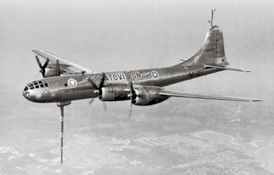 ing antenna for Stratovision is usually hung beneath the aircraft in flight, it naturally has a great command of Line-
ing antenna for Stratovision is usually hung beneath the aircraft in flight, it naturally has a great command of Line-
A Stratovision 25 kW transmitter operating from 30,000 feet (9 km) at 600 MH will achieve a field intensity of 2 millivolts per meter for a 30-
Stratovision tests were undertaken between June 1948 and February 1949. The first phase was undertaken by the Glenn L. Martin Co. and Westinghouse Electric Corporation using a twin-
The second phase of testing was undertaken by these companies using a stripped-
The aircraft received its originating signals from circular dipoles attached to a s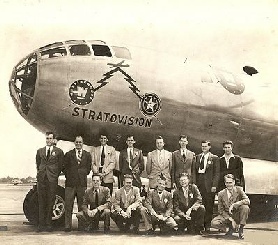 treamlined 8 foot (2.5 m) mast on top of the aircraft's vertical tail fin. The retractable 28 feet (8.5 m) long broadcasting antenna hung vertically beneath the aircraft. It was composed of a two-
treamlined 8 foot (2.5 m) mast on top of the aircraft's vertical tail fin. The retractable 28 feet (8.5 m) long broadcasting antenna hung vertically beneath the aircraft. It was composed of a two-
The receivers, transmitters and necessary air-
On 23 June 1948 the system's airborne transmitter rebroadcast the Republican National Convention, being held in Philadelphia, Pennsylvania, to the surrounding nine-
The tests were watched by many television viewers who sent in reception reports. From these reports it was calculated that Stratovision would require only eight relay planes to provide a transcontinental network and six additional planes to provide coverage to 78% of the United States. Mr. C.E. Nobles who was the head of Stratovision for Westinghouse said in his report:-
"The major technical problems of the system have been solved, and the commercial development awaits only the crystallisation of public demand for the expanded services offered by airborne broadcasting, application of the system by the radio industry to meet this demand, and the clarification of channel facilities available to make possible this application."
In 1961 a nonprofit organisation, Midwest Program on Airborne Television Instruction (MPATI), started a Stratovision service from the airfield of Purdue University as a three-
MPATI delivered its programmes to television channels 72 (KS2XGA) and 76 (KS2XGD) in the UHF band, by transmitting videotaped lectures from the aircraft to an estimated potential 5,000,000 students in 13,000 schools and colleges. The aircraft were equipped with two 2-
The service ended in 1968 when MPATI became embroiled in legal action over their application of Stratovision in a controversy with the Westinghouse company.
During the war in Vietnam, the United States Navy used Stratovision television technology when it flew Operation Blue Eagle from 1966 to 1972 over the Saigon area of South Vietnam. The television programmes were aimed at two audiences on two channels. One for the general public and the other was for the information and entertainment of US troops who were stationed in South Vietnam.
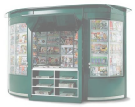

Click on picture to enlarge
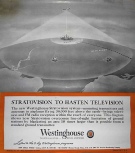
A 1945 press advert from Westinghouse for Stratovision
(Courtesy The Early Television Museum)
Westinghouse and Glenn L. Martin employees with B-
A B-
(Courtesy The Early Television Museum
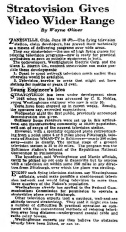
Washington Post
27th June 1948
(Courtesy The Early Television Museum)




Floor 2
Back to







